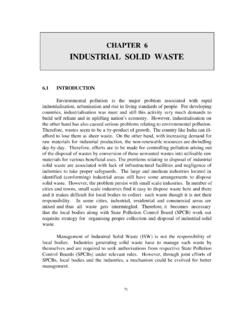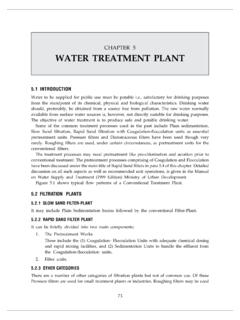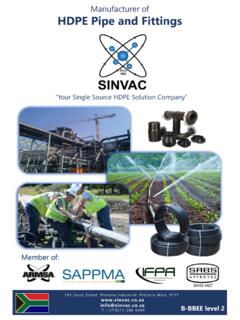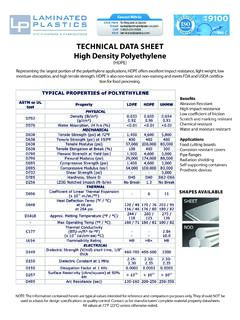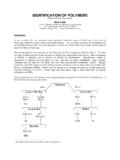Transcription of CHAPTER 4: SEWAGE TREATMENT FACILITIES 4.1 …
1 Part B: Operation and Maintenance4 - 1 CHAPTER 4: SEWAGE TREATMENT FACILITIESCHAPTER 4: SEWAGE TREATMENT INTRODUCTIONS ewage TREATMENT is a multi-stage process designed to treat SEWAGE and protect natural water bodies. Municipal SEWAGE contains various wastes. If improperly collected and improperly treated, this SEWAGE and its related solids could hurt human health and the environment. A TREATMENT plant s primary objectives are to clean the SEWAGE and meet the plant s discharge standards The TREATMENT plant personnel do this by reducing the concentrations of solids, organic matter, nutrients, pathogens and other pollutants in SEWAGE .
2 The plant must also help protect the receiving water body, which can only absorb a certain level of pollutants before it begins to degrade, as well as the human health and environment of its employees and of the challenges of SEWAGE TREATMENT is that the volume and physical, chemical, a limited quantity of pollutants and biological characteristics of SEWAGE continually change. Some changes are the temporary results of seasonal, monthly, weekly or daily fluctuations in the SEWAGE volume and composition. Other changes are long-term, being the results of alterations in local populations, social characteristics, economies, and industrial production or technology.
3 The quality of the receiving water and the public health and well-being may depend on a TREATMENT plant operator s ability to recognize and respond to potential problems. These responsibilities demand a thorough knowledge of existing TREATMENT FACILITIES and SEWAGE TREATMENT PUMP EQUIPMENTR efer to CHAPTER 3 of the Part B Manual. ( Pump Equipment ) FINE SCREEN AND GRIT CHAMBERR efer to CHAPTER 3 of the Part B Manual. ( Screen and Grit Removal ) OIL AND GREASE Manual ProcessThe oil and grease removal unit consists of simple tanks with an underflow baffle where the floating oil and grease is retained on the SEWAGE surface.
4 These are fit only for small STPs of about 1 MLD capacity or less. The floating oil & grease is removed by a rotating slotted pipe as in Figures & actual operation, the scum of oil and grease is removed by rotating the slotted pipe so that the scum flows over the slit, through the pipe and goes to a holding high - density polyethylene (HDPE) tank below the pipe on the outside. The scum is then sold to pollution board-authorized oil re-refining firms. The grit that settles in the trough below is drained to a sump and pumped to the beginning of the grit maintenance is very simple and requires periodic cleaning B: Operation and Maintenance4 - 2 CHAPTER 4: SEWAGE TREATMENT FACILITIESS ource: Figure Typical gravity type oil and grease removal unitSource: Parallel plate separatorPart B: Operation and Maintenance4 - 3 CHAPTER 4.
5 SEWAGE TREATMENT Mechanized ProcessThis process involves floating the oil and grease by either fine bubbles of compressed air or directly by steam liberated near the floor. The same process as in Figures & can also be used by releasing fine bubbles of compressed air or steam near the floor. The air is dispersed into very fine bubbles in the raw SEWAGE and the mixture is released in a shallow tank, where the fine bubbles coalesce with the oil and rise to the surface and are skimmed-off by a scoop pipe as shown in Figure and is typically called a dissolved air floatation (DAF) unit as shown in Figure Source: DAF unit Source: Schematic of DAF unitPart B: Operation and Maintenance4 - 4 CHAPTER 4.
6 SEWAGE TREATMENT FACILITIESAll these units are almost patented types and there are no fixed O&M guidelines. Each unit has to follow the guidelines of the respective EQUALIZATIONFlow equalization can be either side stream or in-line. With in-line flow equalization, all of the flow enters the flow equalization basin, and a constant outflow rate is maintained. With side stream flow equalization, only that portion of the flow above a given flow rate (typically the average flow) is diverted into the flow equalization basin. The accumulated flow is then released during low-flow periods to adjust the total flow to average rate of flow for the in-line flow equalization is the easiest to control.
7 Typically, the flow is pumped out using flow-controlled variable-speed pumps or is pumped in and flows out by gravity using a flow control valve and flow meter. If the latter is used, careful selection of the flow control valve is needed to prevent clogging, even if screened or primary treated SEWAGE is to be side stream flow equalization, flow control gates or variable speed pumps can be used. If a constant elevation side weir is used, achieving a controlled flow rate over the side weir is difficult and is not recommended. Variable speed pumps are a better OperationThe fill-and-draw mode is the most efficient method of operating an equalization basin.
8 The basin is filled during the day when peak flows are occurring, and then it is pumped at night when the plant is receiving low flows and, hence, is more capable of treating excessive flow. If an equalization basin is not operated in fill-and-draw mode, it will act as a mass loading equalization basin only, assuming the basin is completely successful operation of equalization basin requires proper mixing & aeration. The design of mixing equipment provides for blending the contents of the tank and preventing deposition of solids. Mechanical aerators, which offers a method of providing both mixing and aeration, have higher oxygen transfer in clean water under standard conditions than in SEWAGE .
9 The minimum operating depth for floating aerators are typically m and varies with the motor kilowatts and design of the unit. Low-level shutoff controls are needed to protect the unit. If the equalization basin floor is subject to erosion (earthen basins), concrete pads on the basin floor are recommended. Baffling may be necessary to ensure proper mixing, particularly with a circular tank of the recommended monitoring elements required in flow equalization basins are 1. Basin liquid level 2. Basin dissolved oxygen level 3. Influent pH 4. Mixers and/or aeration blower status 5.
10 Influent/effluent status pumps 6. Influent/effluent flowPart B: Operation and Maintenance4 - 5 CHAPTER 4: SEWAGE TREATMENT MaintenanceBecause grit removal is rarely provided before equalization, grit tends to accumulate in the basins. Therefore, provisions for collecting these solids should be made in the design. If the primary purpose of the equalisation basin is flow equalising, then, after the basin has been emptied, following the peak flow event, primary sludge solids will be present in the basin floor. Water cannons or strategically placed cleaning hoses, ideally supplied with plant effluent water, will allow for cleaning the basins.





